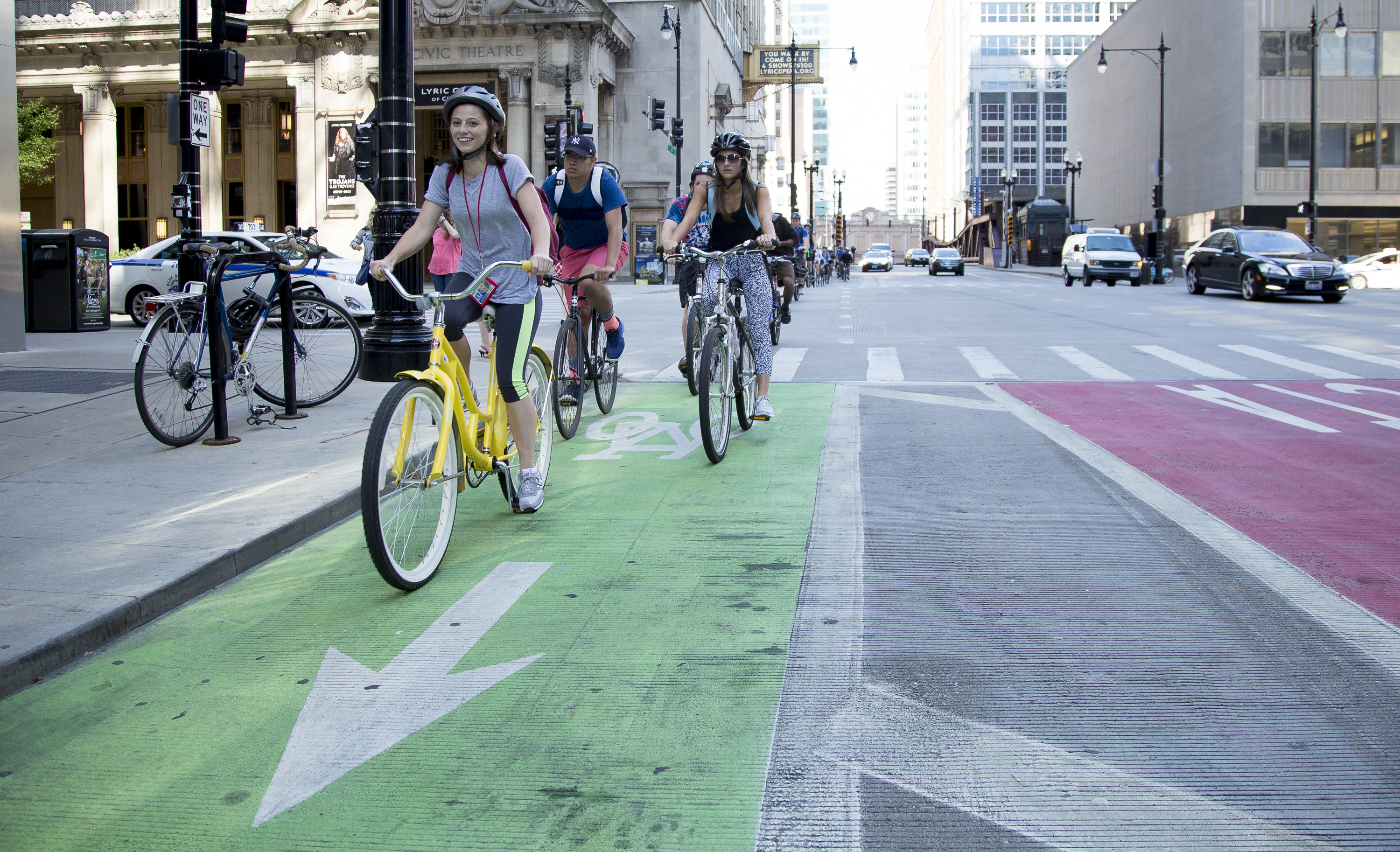 Cyclists ride in a bike lane in downtown Chicago. Research from the Chaddick Institute at DePaul University finds that riding a bike in Chicago is often faster than taking an Uber or the CTA. (DePaul University/Jeff Carrion)
Cyclists ride in a bike lane in downtown Chicago. Research from the Chaddick Institute at DePaul University finds that riding a bike in Chicago is often faster than taking an Uber or the CTA. (DePaul University/Jeff Carrion)CHICAGO — It
is often faster to ride a bicycle through Chicago than to take an Uber or public
transportation, find researchers at DePaul University’s Chaddick Institute for
Metropolitan Development. In a new study, “Policies for Pedaling,” researchers
track the relative speed of bicycle travel, analyze the behavior of cyclists and
recommend policy changes that would accommodate the growing popularity of
cycling on city streets.
In addition
to being fast, many cyclists engage in safe riding behavior at intersections
that is often not consistent with the law, find DePaul researchers. At four-way
stops, just 4 percent of cyclists came to a full stop. However, many cyclists slow
down to yield at stop signs or stop then proceed safely at a red light — a
practice enacted in Idaho in 1982 that is commonly known as the Idaho stop.
"Some of the rules of the road for biking are out of
sync with the realities of the way people move from place to place,” said
Joseph Schwieterman, director of the institute and a co-author of the study,
adding that the Idaho stop is widely considered to be safe. “This study draws
attention to practical ways to deal with these problems — one of which is explore
allowing the Idaho stop at four-way stop intersections." This change could
allow law enforcement to focus instead on cyclists who pose legitimate safety
risks, said Schwieterman.
DePaul graduate students Jenna Caldwell, Riley O’Neil and
Dana Yanocha are co-authors of the study, which calls for Chicago to lower
fines and offer diversion programs to cyclists.
“While Chicago has made tremendous strides in building bike
infrastructure to accommodate the ever-growing cycling population, policymakers
should continue to improve upon and implement policies that keep riders safe,”
said Caldwell.
Researchers conducted field observations of 875 cyclists in
Chicago and found:
- At traffic signals when there was no
cross traffic, 65 percent of riders made an Idaho stop — stopping then
proceeding through the intersection, even on a red light.
- When cross traffic was present, 66
percent of riders made Idaho stops at stop signs, and at traffic signals 78
percent followed the law.
In separate observations, researchers concurrently set out on
routes through the city via bicycle, Uber and CTA buses and trains to see which
was fastest. Researchers found:
- Biking proved faster than public transit on 33 of
45 trips. It was especially faster in travel between neighborhoods, as opposed
to trips in and out of downtown.
- Biking also offered greater predictability — bicyclists
can generally predict travel times within five minutes, while those using the CTA
and UberPool tended to experience much more travel time uncertainty.
The
researchers recommend that policymakers do more to manage the flow of bicycle
traffic, which they note “will require more attention toward creating
enforceable rules and improved policies for issuing citations.” They also commend Chicago for having an
explicit policy for issuing citations to motorists who put bicyclists at risk.
"The
remarkable rise in bicycle travel in Chicago should be celebrated as one of our
city's great success stories of recent years,” said Schwieterman. "This
success, however, is creating a need for new strategies to deal with the traffic
flow on regular streets, bike lanes, the trails."
The
Chaddick Institute for Metropolitan Development at DePaul University
contributes research and educational programs that enable visionary planning in
Chicago and beyond. The study “Policies for Pedaling” can be found at http://bit.ly/chaddickresearch.
###
Source:
Joseph
Schwieterman
jschwiet@depaul.edu
312-362-5732
Media contact:
Kristin
Claes Mathews
kristin.mathews@depaul.edu
312-241-9856